Intel Iris Pro 5200 Graphics Review: Core i7-4950HQ Tested
by Anand Lal Shimpi on June 1, 2013 10:01 AM ESTCompute Performance
With Haswell, Intel enables full OpenCL 1.2 support in addition to DirectX 11.1 and OpenGL 4.0. Given the ALU-heavy GPU architecture, I was eager to find out how well Iris Pro did in our compute suite.
As always we'll start with our DirectCompute game example, Civilization V, which uses DirectCompute to decompress textures on the fly. Civ V includes a sub-benchmark that exclusively tests the speed of their texture decompression algorithm by repeatedly decompressing the textures required for one of the game’s leader scenes. While DirectCompute is used in many games, this is one of the only games with a benchmark that can isolate the use of DirectCompute and its resulting performance.
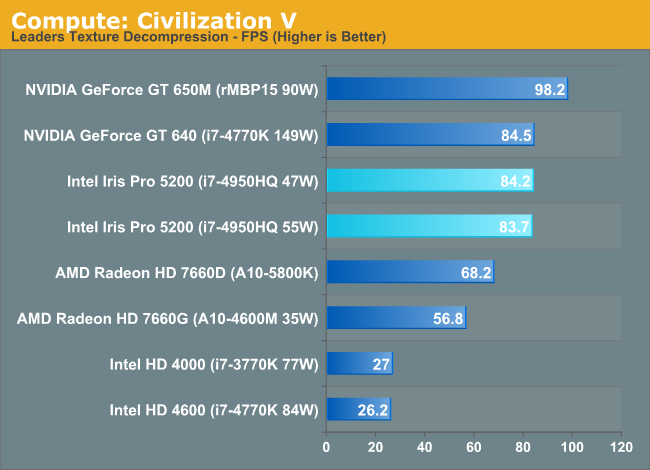
Iris Pro does very well here, tying the GT 640 but losing to the 650M. The latter holds a 16% performance advantage, which I can only assume has to do with memory bandwidth given near identical core/clock configurations between the 650M and GT 640. Crystalwell is clearly doing something though because Intel's HD 4600 is less than 1/3 the performance of Iris Pro 5200 despite having half the execution resources.
Our next benchmark is LuxMark2.0, the official benchmark of SmallLuxGPU 2.0. SmallLuxGPU is an OpenCL accelerated ray tracer that is part of the larger LuxRender suite. Ray tracing has become a stronghold for GPUs in recent years as ray tracing maps well to GPU pipelines, allowing artists to render scenes much more quickly than with CPUs alone.
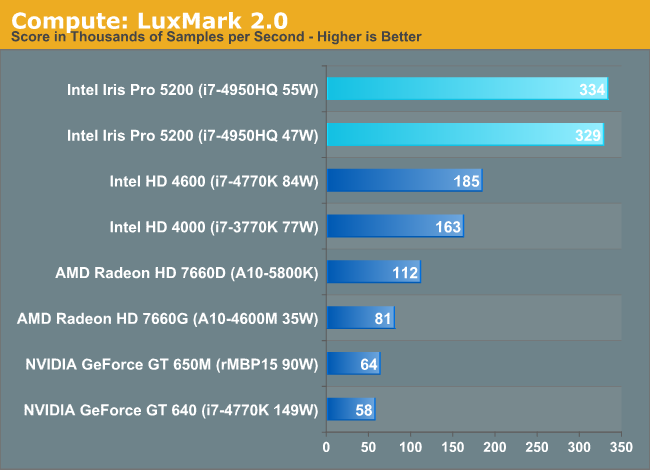
Moving to OpenCL, we see huge gains from Intel. Kepler wasn't NVIDIA's best compute part, but Iris Pro really puts everything else to shame here. We see near perfect scaling from Haswell GT2 to GT3. Crystalwell doesn't appear to be doing much here, it's all in the additional ALUs.
Our 3rd benchmark set comes from CLBenchmark 1.1. CLBenchmark contains a number of subtests; we’re focusing on the most practical of them, the computer vision test and the fluid simulation test. The former being a useful proxy for computer imaging tasks where systems are required to parse images and identify features (e.g. humans), while fluid simulations are common in professional graphics work and games alike.
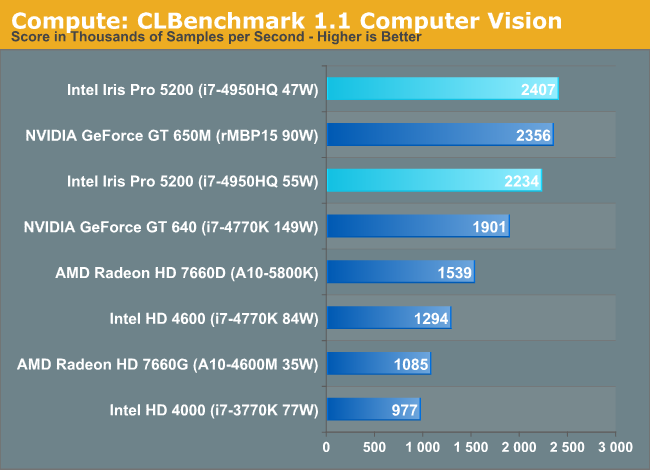
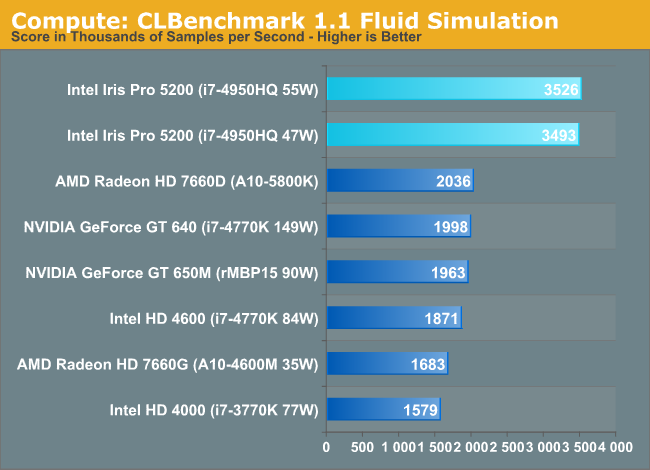
Once again, Iris Pro does a great job here, outpacing everything else by roughly 70% in the Fluid Simulation test.
Our final compute benchmark is Sony Vegas Pro 12, an OpenGL and OpenCL video editing and authoring package. Vegas can use GPUs in a few different ways, the primary uses being to accelerate the video effects and compositing process itself, and in the video encoding step. With video encoding being increasingly offloaded to dedicated DSPs these days we’re focusing on the editing and compositing process, rendering to a low CPU overhead format (XDCAM EX). This specific test comes from Sony, and measures how long it takes to render a video.
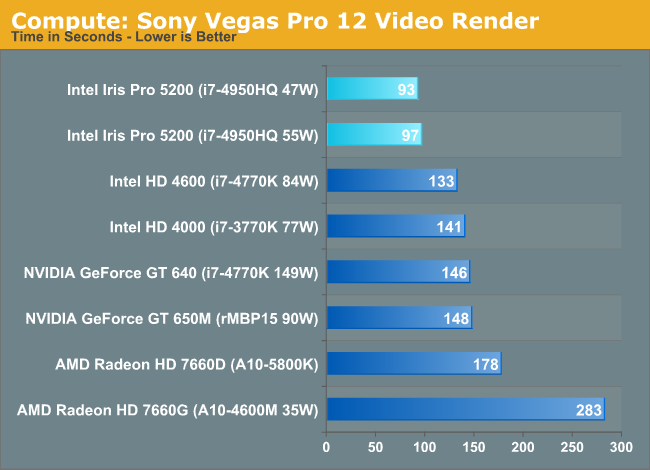
Iris Pro rounds out our compute comparison with another win. In fact, all of the Intel GPU solutions do a good job here.










177 Comments
View All Comments
Old_Fogie_Late_Bloomer - Monday, June 3, 2013 - link
The performance isn't earth-shattering, but if Intel manages to put out good open-source Linux drivers for Iris Pro, I can't help but feel like this would be a great chip for that; it isn't like you'll be playing Crysis in Ubuntu anytime soon. I kind of want that CRB (or something like it), actually.tviceman - Saturday, June 1, 2013 - link
I'll bet notebooks with mid-range quad core CPU's and gt 750m discrete graphics will be cheaper than notebooks with Iris Pro enabled iGPU graphics as well. The only benefit would be a slightly slimmer chassis and battery life. Anyone who still wants to game on a notebook is noticeably better off with a mid-range discrete GPU over this.esterhasz - Saturday, June 1, 2013 - link
On page four, the ominous launch partner is not "keen" rather than "key", I guess. I'd be very keen on having that rMBP 13" with IP5200, though.Ryan Smith - Saturday, June 1, 2013 - link
Noted and fixed. Thank you.tipoo - Saturday, June 1, 2013 - link
I'm very much in that boat too, a quad core 13" rMBP with Iris Pro would put it over the top.MattVincent - Wednesday, June 12, 2013 - link
totally agree. I wonder if apple will actually put a quad core in the 13" though. I bet they would rather sell more 15" rmbp'sjeffkibuule - Saturday, June 1, 2013 - link
Would a 47W chip be able to fit into a normal 13" Ultrabook-like chassis like the 13" MacBook Pro with Retina Display? Only an extra 12W TDP to deal with.esterhasz - Saturday, June 1, 2013 - link
This would be awesome and we have to remember that the 47W TDP includes voltage regulation moving off the MB, so the gap is maybe only 8W. The 47 TDP also refers to both CPU and GPU running at full speed, which is an extremely rare scenario - in gaming, the CPU load will probably hover at 50% only.In any case, if the tested model goes into a rMBP 13" I'm going to buy it before Tim Cook has left the stage.
nofumble62 - Saturday, June 1, 2013 - link
Thinking to buy a Ivybridge Mac Book Pro for my wife, I guess she will have wait a little longer for this baby. I wish they could fit in a Mac Book Air.jeffkibuule - Saturday, June 1, 2013 - link
Look at the price of those chips though, you're going to be dropping at least $2000 on such a laptop when the CPU alone is $478.